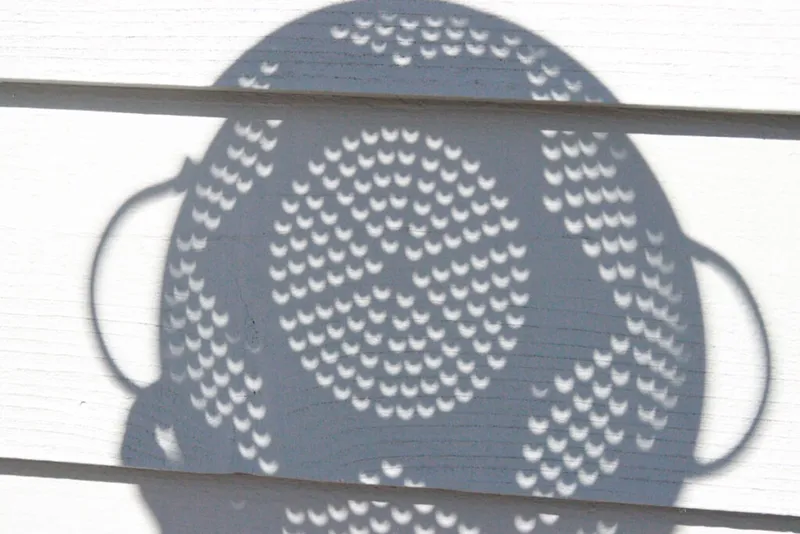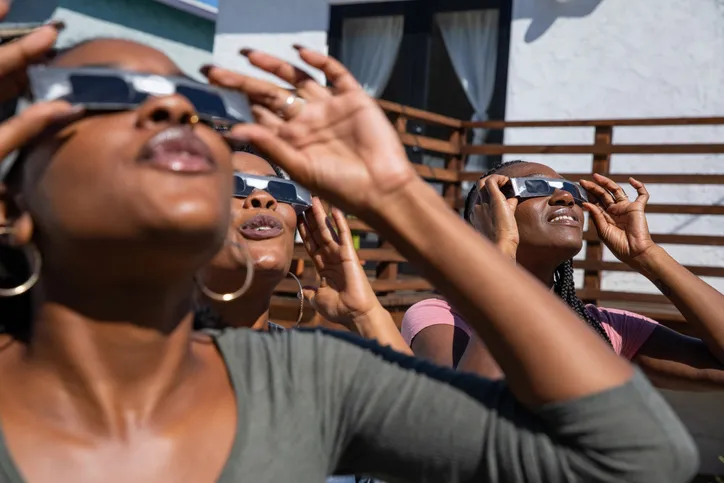If there's an upcoming solar eclipse event near you, it pays to explore what options you have to safely view a solar eclipse, and there are a range of simple - and not so simple - ways you can do so.
A solar eclipse is a wonderful thing.
Those of us who have been lucky enough to witness totality are well aware of the ethereal, life-changing moment that occurs when darkness descends and the the Moon blocks out the light from our host star the Sun.
And that's what makes a solar eclipse so special.
Of course, not all solar eclipses are total solar eclipses. Depending on where you view the eclipse, you many only see a partial solar eclipse.
If you're getting ready for the April 8 2024 solar eclipse, read on for our guide on how to view it safely.
- Find out when the next eclipse is taking place
Video: Safely observing a solar eclipse
When observing the Sun, safety is key. You should never observe the Sun with the naked eye or with homemade equipment.
Only ever use certified solar filters, solar telescopes or eclipse glasses to view the Sun or a solar eclipse.
Here are some ways you can safely observe a solar eclipse.
5 ways to safely view a solar eclipse
Projection through a colander

Pros
- Cheap and easy
- Great for large groups of people
Cons
- Views are quite small
- No detail can be seen apart from the crescents
Equipment
- Colander
- Piece of white card
Simply hold up a kitchen colander during an eclipse and you will see that myriad small crescents – corresponding to the eclipsed phase of the Sun – are cast in the shadow.
Each hole acts in the same way as a pinhole camera, projecting an inverted image of the Sun, and this works even if the holes are not round.
This effect can also be seen when sunlight shines through leaves on a tree or other foliage, with the gaps between leaves acting as pinholes and creating crescents of light in the shade on the ground.
Casting the image onto a white piece of card held about 50cm away will increase the contrast, making the event easier to see, however any light-coloured surface will work.

Try varying this distance to find the sharpest image, as the size of the holes in different colanders will affect the view.
This method is the cheapest and easiest way for a group of people to simultaneously view the eclipse and its progress with no risk to either eyesight or equipment.
The results can be easily photographed using any conventional camera.
The only downside is the size of the crescents are quite small.
Increasing the distance between the colander and the projection screen will make the crescents larger, but also less defined.
As such, other than the crescent itself, no details such as sunspots can be seen.
Eclipse glasses

Pros
- Easy
- Can see some of the Sun's detail
Cons
- Cannot take images
- Cannot see as much detail as with a solar telescope
Equipment
- Get a pair of solar eclipse glasses from a certified retailer. Accept no substitutes!
Solar eclipse glasses are perhaps the easiest way of directly observing a solar eclipse. Simply put on your certified solar eclipse glasses and look up!
Solar eclipse glasses are safe because they block all but a small amount of the Sun’s ultraviolet, visible and infrared light, meaning the wearer can observe the Sun without causing damage to their eyesight.
However, looking at the Sun for long periods is unadvisable, even with eclipse glasses on. Aim to observe in short stints instead.
And only buy certified safe solar eclipse glasses from reputable suppliers.
Look for the International Organization for Standardization (ISO) mark, the ISO 12312-2 standard for filters.
Some suppliers will even provide you with a report showing compliance with ISO 12312-2.
And also be sure to check the lenses for scratches and tears first.
Solar eclipse glasses allow you to see the detail of the Sun with your own eyes, but of course they don't allow you to take any photos.
View through a white light filter

Pros
- Can be adapted to fit any telescope
- Quick and portable option
- Can see good detail on the Sun
Cons
- Requires careful construction (if in doubt, don't attempt!)
- Materials used are perishable and must be checked for defects
Equipment
- Solar safety film
- Card
- Sticky tape
- Telescope
One of the best ways to safely a solar eclipse is to fit a white light filter over the front of your telescope.
Filters are relatively simple to make using sheets of certified solar film cut to size.
Once you’ve made your filter, you must check it for pinprick holes and tears each time you’re about to fit it.If you find any, discard the filter and make a new one.
Make sure that the mask fits over the entire aperture and that no light can leak around its edges
When you use the filter, it’s important to also remove or cap your telescope’s finder.
Always make sure the telescope is pointing away from the Sun before fitting the filter.
When you’re done observing, do the same – aim the telescope away from the Sun before removing it.
View in Hydrogen Alpha

Pros
- Great levels of detail
- Options available for using regular scopes
Cons
- More expensive than other methods
Equipment
- A hydrogen alpha refractor
- Or an etalon filter system
A variety of manufacturers offering dedicated hydrogen-alpha telescopes or filter sets that fit onto regular telescopes.
A dedicated hydrogen-alpha refractor offers the easiest and most affordable way to see our star in this way.
All you need is a suitable mount and eyepiece to get observing.
If you already own a good refractor or Schmidt-Cassegrain telescope, it is possible to buy an etalon filter system to go on the objective lens, and used with a blocking filter on the rear of the scope it offers excellent views.
Whichever method you choose hydrogen-alpha views are simply stunning, with a wealth of features on show.
Use a solar projection screen

Pros
- Incredibly safe, as you are observing the Sun indirectly
- Good for observing in groups
- Easy and safe for children to see
Cons
- Requires a bit of preparation
- Lack of detail on solar surface
It is possible to project a view of the Sun or a solar eclipse onto a screen, allowing for safe observation of our host star.
For more info, find out how to make a solar projection screen.
